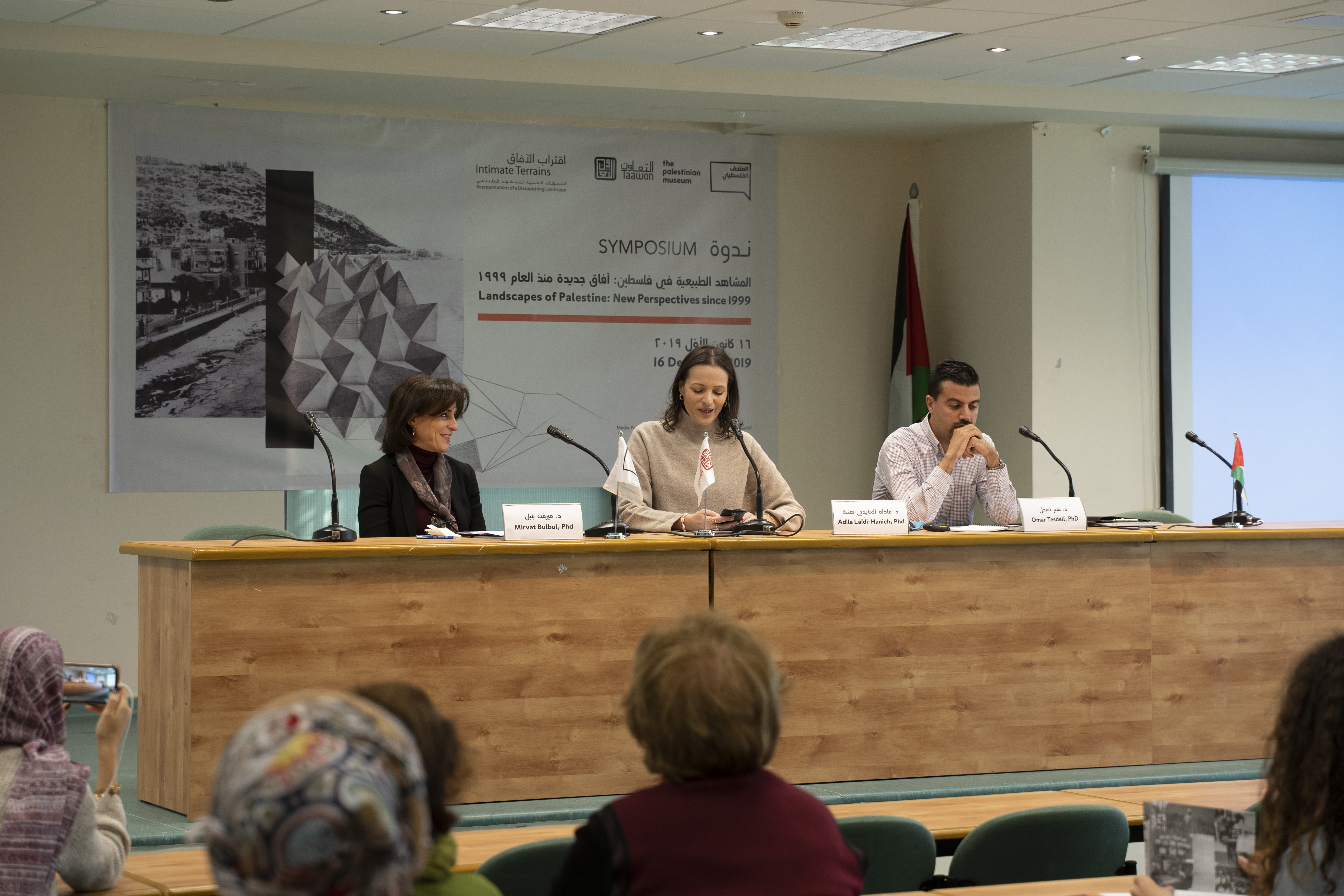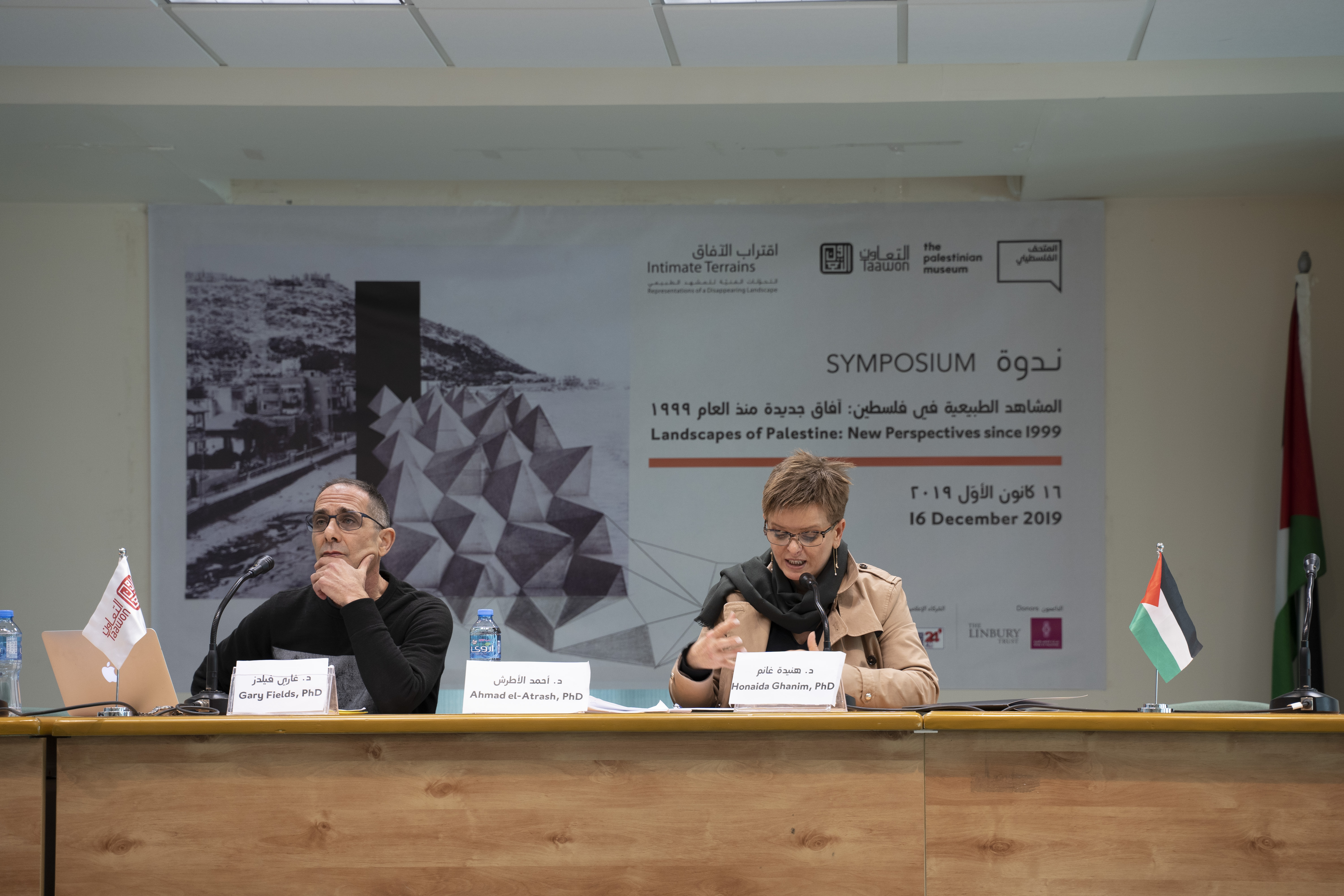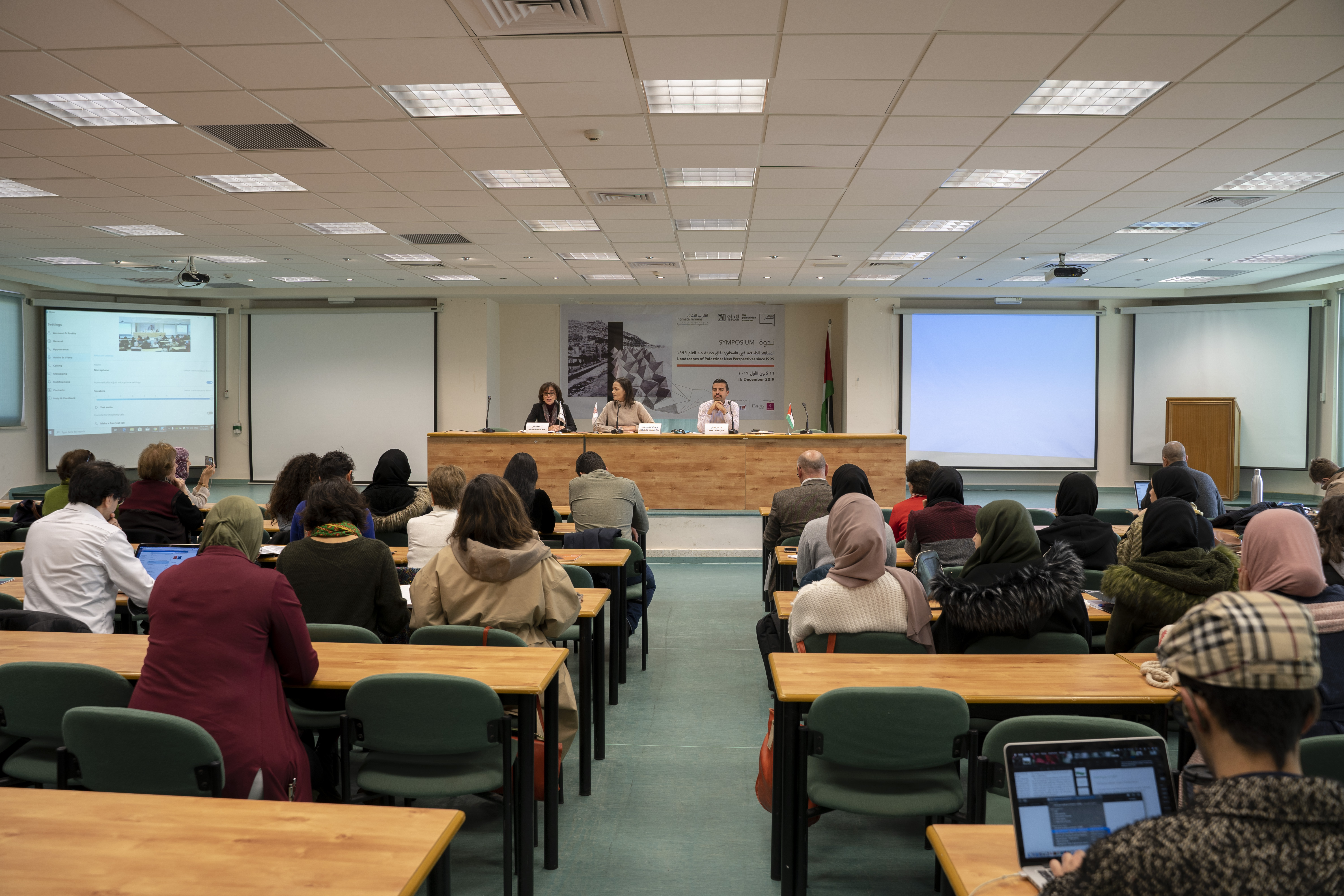


|
The Palestinian Museum Holds its First Annual Symposium
21/12/2019 – Birzeit: The Palestinian Museum held its first annual symposium, titled ‘Palestinian Landscapes: New Perspectives since 1999’ on 16 December at Muwatin Institute in Birzeit University. The event concludes the Museum’s programme that has accompanied its outgoing exhibition, Intimate Terrains: Representations of a Disappearing Landscape.
The symposium built on a conference held in 1999 in Birzeit University, which featured prominent Palestinian and international researchers, including Edward Said and Ibrahim Abu-Lughod, and which resulted in the publishing of a book about the Palestinian Landscape. 20 years on, the Museum sought to shed light on the transformations that have taken shape in the landscape amid the shifts in political, social, economic and environmental conditions over the last two decades, and to deepen the discussion of Intimate Terrains.
In her opening address, Director General of the Palestinian Museum, Adila Laïdi-Hanieh, PhD, stressed the importance of the Museum’s Knowledge and Research Programme, which develops and organises a range of activities and events that promote knowledge production and its dissemination to different sectors of Palestinian society. These events include international conferences and symposia, workshops, and open calls for research papers on contemporary Palestinian culture.
The symposium opened with a keynote lecture by assistant professor in Birzeit University’s Department of Geography, Omar Tesdell, PhD, about the study of the Palestinian landscape over the last 20 years. Titled ‘The Landscape of Palestine: An Agroecological History’, the lecture probed the agroecological transformations in Palestine and the effects of human activity on the natural landscape.
The first session, titled ‘the Land and the People: Physical Landscapes and Human Space’, commenced with a presentation by Honaida Ghanim, PhD, chief editor of the Palestinian Forum for Israeli Studies, MADAR’s Strategic Report. In her presentation, titled ‘Geographies of Power: Borders and the Dialogue of Connection and Separation in Palestine’, Ghanim related her grandfather’s personal experience as the Israeli occupation severed part of his village in Tulkarm. She went on to share recollections of her relationship to the place and its borders, which were redrawn by force.
Dr Gary Fields, professor of Communication and Urban Studies at the University of California, San Diego offered a presentation titled ‘No Entry! The Palestinian Landscape in a Historical Frame’. He shed light on the Palestinian landscape as part of a recurring pattern of colonisation, involving the expropriation of territory by groups with colonialist ambitions in other peoples’ lands. Such acts, fields explained, are justified by those groups under the pretext of the lands being empty and owing to the colonisers’ supposed superior ability to ensure their development.
Palestinian writer and PhD candidate in Sociology and Anthropology at the University of Haifa, Nisreen Mazzawi, presented ‘Transformations in the Urban Landscape of Palestinian Towns of the Galilee; Nazareth and the Galilee as an Example’. She explored the reality of Palestinian villages inside 1948-occupied Palestine, and the Israeli occupation regime’s actions through its planning mechanisms and the establishment of regional councils, in its efforts to control these areas and to curb the influence of Palestinian towns and limit their geographic contiguity.
Palestinian-Syrian systems design engineer, Majd al-Shihabi, addressed the symposium via video, and presented ‘Palestine Open Maps, and the Use of Digital Technology to Decolonise the Mandate Period Archive’. The project consists of a collection of maps drawn by various entities, including the British during the 1930s and 40s. Their significance lies in their being the last maps of Palestine to be drawn before partition and the Nakba. In addition to detailing the geography of Palestine, the maps identify the original Arabic names of landmarks as well as towns and villages, while containing thorough localised details.
Visiting assistant professor in urban studies and spatial practices at Brad College, al-Quds University, Ahmad el-Atrash, PhD, concluded the symposium’s first session with a presentation titled ‘Harnessing Urbanisation for Development According to Land Availability and Suitability in the West Bank’. El-Atrash shed light on urban development in Palestine and the future of Palestinian social planning in the West Bank according the National Urbanisation Policy (NUP) adopted by the State of Palestine.
The Symposium’s second session, titled ‘Intimate Terrains: the Visual, the Digital and the Material; Art and Temporality’ opened with a presentation by Dr Emile Badarin, postdoctoral research fellow at the European Neighbourhood Policy Chair, College of Europe. Titled ‘Palestinian Politics of Visual and Aesthetic Resistance and Dissent’, Badarin’s presentation examined the decades of ‘peace’ discourse and ongoing settler-colonial activity in Palestine, which in addition to disrupting the Palestinian landscape, have also altered Palestinians’ conceptualisation of their own scenery. The political reality has also dominated the framing of Palestinians’ thinking about land and political imagination.
Palestinian-Syrian journalist and writer, Salim al-Beik addressed the symposium via video with a presentation titled ‘I Am That “Other” Who Belongs to Palestine’, in which he discussed, from a literary perspective, his relation to place as a Palestinian.
Architect and academic, Yara Sharif, PhD, gave a presentation titled ‘Landscape and Immobility’. She relayed her analysis of the state of the Palestinian landscape amid the Israeli occupation regime’s actions and the subsequent representation of the Palestinian people as a passive one, able only to interact with what is granted or imposed by Israel. The Palestinian people, who for generations has lived on the land, cultivating it with its own traditions and horticulture, has now been left out of the scene as though it were alien to it.
Helga Tawil-Souri, PhD, associate professor in the Department of Middle East and Islamic Studies at New York University addressed the symposium via video with a presentation titled ‘Visual Whereabouts: Palestinian Landscape as Mediated Forms’. Tawil-Souri tackled the question of land and distance, the duty to document Palestine, and the means by which to do so, using Intimate Terrains as an example. The exhibition, according to Tawil-Souri, succeeded in creating space for imagination, recollection, and illumination on a multi-faceted, individual and collective level, making it one of the most significant visual culture productions in this regard.
The Palestinian Museum will issue a publication containing the research papers presented at this symposium, as well as all papers submitted through the intellectual activities and events held throughout the duration of the exhibition. Video of the symposium is available on the Museum’s YouTube channel .
Intimate Terrains explores the changing representation of landscape by Palestinian artists, and our relationship to place and location through the themes of erasure, fragmentation, distance and belonging in a spectrum of artworks drawn from the 1930s to the present day. |